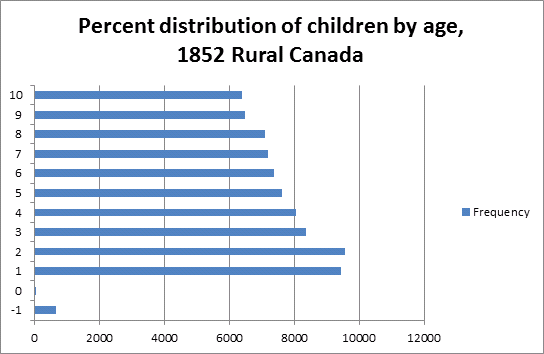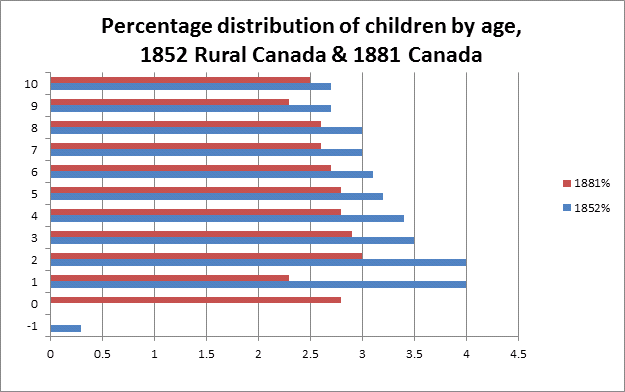Analysis of the Age Variable, 1852 Census of Canada
Lisa Dillon
April, 2013
The 1852 census enumerator instructions stipulated that census takers were to provide age at next birthday, rather than age as of last birthday, as became the practice in subsequent Canadian censuses. As far as we can tell with respect to babies, it seems that many or most enumerators followed this instruction : for example, in the PRDH 1852 20% sample, there were 7,665 valid responses to the question « Born in 1851 ». Of these, 91% indicated an age of 1 attributed by the enumerator. Another 2% gave an age of 2, while another 7% gave an age in months but no year indication. Very few enumerators in the 1852 rural sample used the value “0”, while in relatively few 663 instances (3.4% of all children up to and including age 2 and just .3% of all persons), enumerators gave age in months only, indicating a certain level of confusion for some. Most revealing is the simple distribution of children aged 10 or less by single years of age:
this distribution reveals equal percentages distributed in age 1 and age 2 (4% of all persons) and a marked drop in the percentage listed as age 3 (3.5% of all persons). In contrast, in the 1881 100% sample, the percentage of children aged 3 (2.9% of all persons) was just slightly less than the percentage given as age 2 (3% of all persons). The 1852 result suggests that 1852 enumerators followed the prescribed census rule for the very youngest children, advancing the age of infants to age 1 and that of toddlers to age 2. However, the large gap between the proportion of “2-year-olds” and “3-year-olds” is telling: it suggests that some children who had already celebrated their 2nd birthday but had not yet reached age 3 were enumerated as 3-year olds while others were enumerated as 2-year-olds. The more gentle gaps between subsequent ages suggests that with children and persons of older ages, enumerators either noted persons as of
their last birthday or varied between last and next birthday. (This may explain why Katrina Joubert’s child-woman ratios for 1852 do not seem to make sense if she advances the age threshold of children from 4 years to 5 years). Once enumerators were dealing with adult-aged persons, age rounding and general inexactitudes of age declarations which afflict all early censuses probably influenced age declarations to a greater extent than the unique 1852 rule to note age as of last birthday.
In these graphics, note that -1 = age stated in months only
I don’t know why there are fewer babies enumerated at age 1 in 1881 than age 0 or 2, or why there are fewer children aged 0 than 2, but it could be because of under-enumeration of babies in general which could happen in censuses (they forgot to tell the enumerator about the baby); there are probably fewer children noted as “age 9” than “age 10” in 1881 because of age rounding.
Note Gauvreau, Gervais & Gossage did a similar analysis, published as an appendix in La Fécondité des Québécoises 1870-1970: D’une exception à l’autre (2007). They found in 1871 a “deficit” of children aged 1 to the “benefit” of those given the ages 0 and 2. They concluded that this was not a problem for fertility analysis as long as they grouped together all children under the age of 5. Gauvreau, Gervais & Gossage went a step further in comparing census age statements to those derived from baptismal registers for a selection of persons. (Danielle Gauvreau, Diane Gervais and Peter Gossage, La Fécondité des Québécoises 1870-1970: D’une exception à l’autre. Québec : Boréal, 2007, pp 277-279).

